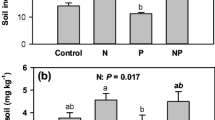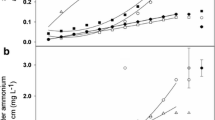Abstract
Ideal bioenergy feedstocks are low in nutrients that act as anti-quality factors during conversion processes. Research has shown that delaying harvest of temperate perennial grasses until late winter reduces nutrient content, primarily due to end-season resorption, but also indicates a role for foliar nutrient leaching. While end-season resorption has been estimated, foliar nutrient leaching has not, and is a factor that could refine harvest recommendations. Additionally, establishing a baseline of mineral loss during switchgrass senescence will improve our understanding of leaf-level nutrient resorption. Therefore, we applied simulated rainfall to replicated (n = 5) plots within a previously established switchgrass stand to determine if heavy precipitation can induce nutrient leaching in senescing, unharvested foliage. Hour-long simulated rainfalls of ∼120 mm were applied every 2 weeks from early September to a killing frost in 2014 and 2015. Leaf samples were taken from the upper and lower canopy before and after simulated rainfalls and from no-rain controls and analyzed for elemental N, P, K, S, Mg, and Ca. Nutrient resorption estimates ranged from 33 to 82% in control plots. Comparison of rainfall plots to controls indicated that lower canopy leaves, upon reaching ≥50% senescence, were slightly susceptible to foliar nutrient leaching, with losses ranging from 0.3 to 2.8 g kg−1 dry matter for K, P, and Mg. Nitrogen, Ca, and S were not susceptible to foliar leaching. Although statistically significant (P ≤ 0.05), these values suggested that foliar leaching was not a strong driver of nutrient loss during senescence.




Similar content being viewed by others
References
Mitchell R, Schmer M, Anderson W, Jin V, Balkcom K, Kiniry J, Coffin A, White P (2016) Dedicated energy crops and crop residues for bioenergy feedstocks in the central and eastern USA. BioEnergy Research 9(9):384–398
Sanderson MA, Adler PR (2008) Perennial forages as second generation bioenergy crops. Int J Mol Sci 9(5):768–788
Yang J, Worley E, Wang M, Lahner B, Salt DE, Saha M, Udvardi M (2009) Natural variation for nutrient use and remobilization efficiencies in switchgrass. BioEnergy Research 2(4):257–266
Adler PR, Sanderson MA, Boateng AA, Weimer PJ, Jung H-JG (2006) Biomass yield and biofuel quality of switchgrass harvested in fall or spring. Agron J 98(6):1518–1525
Nassi o Di Nasso N, Roncucci N, Bonari E (2013) Seasonal dynamics of aboveground and belowground biomass and nutrient accumulation and remobilization in giant reed (Arundo donax L.): a three-year study on marginal land. BioEnergy Research 6(2):725–736
Heaton EA, Dohleman FG, Long SP (2009) Seasonal nitrogen dynamics of Miscanthus× giganteus and Panicum virgatum. GCB Bioenergy 1(4):297–307
Parrish DJ, Fike JH (2005) The biology and agronomy of switchgrass for biofuels. Critical Reviews in Plant Science 24(5–6):423–459
Johnson JM, Gresham GL (2013) Do yield and quality of big bluestem and switchgrass feedstock decline over winter? BioEnergy Research 7(1):68–77
Lewandowski I, Scurlock JM, Lindvall E, Christou M (2003) The development and current status of perennial rhizomatous grasses as energy crops in the US and Europe. Biomass Bioenergy 25(4):335–361
Anderson W, Sarath G, Edme S, Casler M, Mitchell R, Tobias C, Hale A, Sattler S, Knoll J (2016) Dedicated herbaceous biomass feedstock genetics and development. BioEnergy Research 9(2):399–411
Davidsson K, Korsgren J, Pettersson J, Jäglid U (2002) The effects of fuel washing techniques on alkali release from biomass. Fuel 81(2):137–142
Lewandowski I, Kicherer A (1997) Combustion quality of biomass: practical relevance and experiments to modify the biomass quality of Miscanthus x giganteus. Eur J Agron 6(3):163–177
van der Weijde T, Alvim Kamei CL, Torres AF, Vermerris W, Dolstra O, Visser RG, Trindade LM (2013) The potential of C4 grasses for cellulosic biofuel production. Front Plant Sci 4:107
Tahir MHN, Casler MD, Moore KJ, Brummer EC (2011) Biomass yield and quality of reed canary grass under five harvest management systems for bioenergy production. BioEnergy Research 4(2):111–119
Sadeghpour A, Gorlitsky L, Hashemi M, Weis S, Herbert S (2014) Response of switchgrass yield and quality to harvest season and nitrogen fertilizer. Agron J 106(1):290–296
Kludze H, Deen B, Dutta A (2013) Impact of agronomic treatments on fuel characteristics of herbaceous biomass for combustion. Fuel Process Technol 109:96–102
Prochnow A, Heiermann M, Plöchl M, Amon T, Hobbs P (2009) Bioenergy from permanent grassland—a review: 2. Combustion Bioresource Technology 100(21):4945–4954
Dien BS, Jung H-JG, Vogel KP, Casler MD, Lamb JF, Iten L, Mitchell RB, Sarath G (2006) Chemical composition and response to dilute-acid pretreatment and enzymatic saccharification of alfalfa, reed canary grass, and switchgrass. Biomass Bioenergy 30(10):880–891
Sarath G, Baird LM, Mitchell RB (2014) Senescence, dormancy and tillering in perennial C 4 grasses. Plant Sci 217:140–151
Vergutz L, Manzoni S, Porporato A, Novais RF, Jackson RB (2012) Global resorption efficiencies and concentrations of carbon and nutrients in leaves of terrestrial plants. Ecol Monogr 82(2):205–220
Cadoux S, Riche AB, Yates NE, Machet J-M (2012) Nutrient requirements of Miscanthus x giganteus: conclusions from a review of published studies. Biomass Bioenergy 38:14–22
Brant AN, Chen HY (2015) Patterns and mechanisms of nutrient resorption in plants. Crit Rev Plant Sci 34(5):471–486
Van Heerwaarden L, Toet S, Aerts R (2003) Current measures of nutrient resorption efficiency lead to a substantial underestimation of real resorption efficiency: facts and solutions. Oikos 101(3):664–669
Aerts R (1996) Nutrient resorption from senescing leaves of perennials: are there general patterns? Journal of Ecology Aug 1:597–608
Thomas H (2013) Senescence, ageing and death of the whole plant. New Phytol 197(3):696–711
White P (2012) Long-distance transport in the xylem and phloem. In: Marschner P (ed) Marschner’s mineral nutrition of higher plants. Academic Press, San Diego, CA, pp 49–70
Hill J (1980) The remobilization of nutrients from leaves. J Plant Nutr 2(4):407–444
Christian D, Riche A, Yates N (2002) The yield and composition of switchgrass and coastal panic grass grown as a biofuel in southern England. Bioresour Technol 83(2):115–124
Himken M, Lammel J, Neukirchen D, Czypionka-Krause U, Olfs H-W (1997) Cultivation of Miscanthus under west European conditions: seasonal changes in dry matter production, nutrient uptake and remobilization. Plant Soil 189(1):117–126
Epstein E, Bloom AAJ (2005) Mineral nutrition of plants: principles and perspectives. Sinauer Associates, Incorporated, Sunderland, MA
Clark FE (1977) Internal cycling of nitrogen in short grass prairie. Ecology:1322–1333
Bhandari HS, Walker DW, Bouton JH, Saha MC (2014) Effects of ecotypes and morphotypes in feedstock composition of switchgrass (Panicum virgatum L.) GCB Bioenergy 6(1):26–34
Wilson DM, Dalluge DL, Rover M, Heaton EA, Brown RC (2013) Crop management impacts biofuel quality: influence of switchgrass harvest time on yield, nitrogen and ash of fast pyrolysis products. BioEnergy Research 6(1):103–113
Eichert T, Fernandez V (2012) Uptake and release of elements by leaves and other aerial plant parts. In: Marschner P (ed) Marschner’s mineral nutrition of higher plants. Academic Press, San Diego, CA, pp 71–84
Bloem E, Haneklaus S, Schnug E (2010) Experimental leaching of macronutrients from Brassica napus L. increases with leaf age and growth stage. J Plant Nutr 34(2):258–271
Clement C, Jones L, Hopper M (1972) The leaching of some elements from herbage plants by simulated rain. Journal of Applied Ecology Apr 1:249–260
Tukey H Jr (1970) The leaching of substances from plants. Annu Rev Plant Physiol 21(1):305–324
Natural Resources Conservation Service SSD (2001) Official Soil Series Descriptions. United States Department of Agriculture. http://ortho.ftw.nrcs.usda.gov/osd/
NWS COOP Network (2016) http://mesonet.agron.iastate.edu/request/coop/fe.phtml. Accessed April 1, 2016
Miller W (1987) A solenoid-operated, variable intensity rainfall simulator. Soil Sci Soc Am J 51(3):832–834
Littell RC, Pendergast J, Natarajan R (2000) tutorial in biostatistics: modelling covariance structure in the analysis of repeated measures data. Stat Med 19(1793):1819
Fernandez-Escobar R, Moreno R, Garcıa-Creus M (1999) Seasonal changes of mineral nutrients in olive leaves during the alternate-bearing cycle. Sci Hortic 82(1):25–45
Picchioni G, Brown P, Weinbaum S, Muraoka T (1997) Macronutrient allocation to leaves and fruit of mature, alternate-bearing pistachio trees: magnitude and seasonal patterns at the whole-canopy level. J Am Soc Hortic Sci 122(2):267–274
Grzebisz W (2015) Magnesium. In: Barker A, Pilbeam D (eds) Handbook of plant nutrition. CRC Press, Boca Raton, FL, pp 199–260
Hawkesford M, Horst W, Kichey T, Lambers H, Schjoerring J, Skrumsager Moller I, White P (2012) Functions of macronutrients. In: Marschner P (ed) Marschner’s mineral nutrition of higher plants. Academic Press, San Diego, CA, pp 135–189
Bertiller M, Sain C, Carrera A, Vargas D (2005) Patterns of nitrogen and phosphorus conservation in dominant perennial grasses and shrubs across an aridity gradient in Patagonia, Argentina. J Arid Environ 62(2):209–223
Heggenstaller AH, Moore KJ, Liebman M, Anex RP (2009) Nitrogen influences biomass and nutrient partitioning by perennial, warm-season grasses. Agron J 101(6):1363–1371
Xiong S, Landström S, Olsson R (2009) Delayed harvest of reed canary grass translocates more nutrients in rhizomes. Acta Agriculturae Scandinavica Section B–Soil and Plant Science 59(4):306–316
Lewandowski I, Heinz A (2003) Delayed harvest of Miscanthus—influences on biomass quantity and quality and environmental impacts of energy production. Eur J Agron 19(1):45–63
Beale C, Long S (1997) Seasonal dynamics of nutrient accumulation and partitioning in the perennial C4 grasses Miscanthus× giganteus and Spartina cynosuroides. Biomass Bioenergy 12(6):419–428
Fageria NK (2015) Potassium. In: Barker A, Pilbeam D (eds) Handbook of plant nutrition. CRC Press, Boca Raton, FL, pp 127–163
Collins M (1982) The influence of wetting on the composition of alfalfa, red clover, and birdsfoot trefoil hay. Agron J 74(6):1041–1044
de Aldana BV, Geerts R, Berendse F (1996) Nitrogen losses from perennial grass species. Oecologia 106(2):137–143
Christian DG, Yates NE, Riche AB (2006) The effect of harvest date on the yield and mineral content of Phalaris arundinacea L. (reed canary grass) genotypes screened for their potential as energy crops in southern England. J Sci Food Agric 86(8):1181–1188
Acknowledgments
This work was supported by the USDA National Institute of Food and Agriculture Hatch project 1008969, by funding from the North Central Regional Sun Grant Center at South Dakota State University through the Sun Grant Initiative, and by the Agronomy Fellowship from the Department of Agronomy at Iowa State University. We thank Catherine Bonin Hunt, Nicholas Boersma (and Stephanie Boersma), Elke Brandes, Mauricio Tejera, Danielle Wilson, Glyn Powell, Valeria Cano Camacho, Alexander Degaetano, and Collin Coon for assistance with this project. We would particularly like to thank Jeff Cook for technical and field assistance with the outdoor rainfall simulator.
Author information
Authors and Affiliations
Corresponding author
Rights and permissions
About this article
Cite this article
Burke, R.H., Moore, K.J., Shipitalo, M.J. et al. All Washed Out? Foliar Nutrient Resorption and Leaching in Senescing Switchgrass. Bioenerg. Res. 10, 305–316 (2017). https://doi.org/10.1007/s12155-017-9819-6
Published:
Issue Date:
DOI: https://doi.org/10.1007/s12155-017-9819-6




